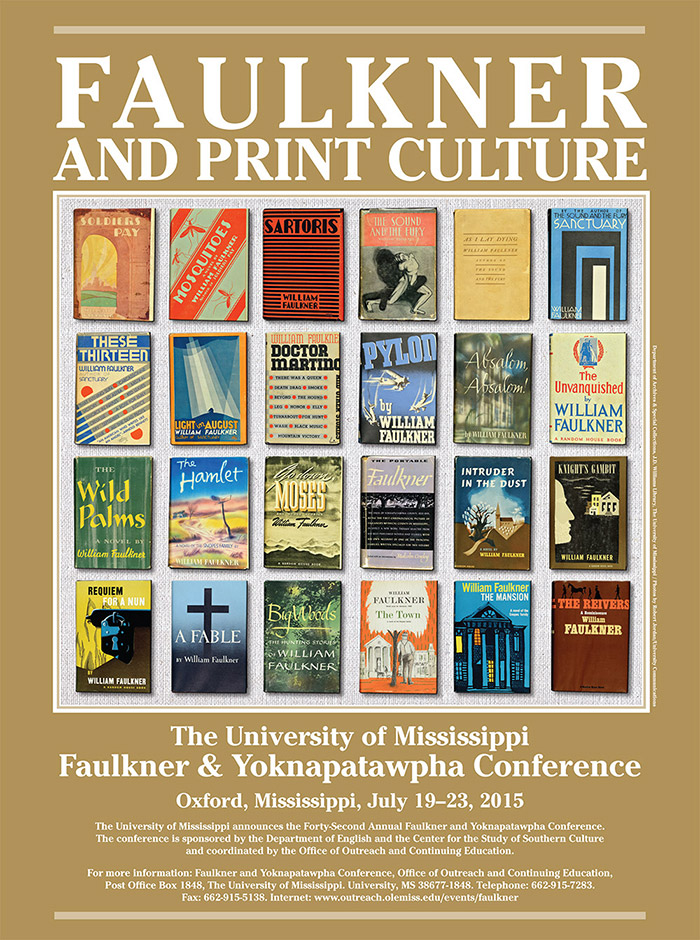
Panel. Sound, Vision, Print
Location
Nutt Auditorium
Start Date
22-7-2015 8:00 AM
Description
- Faulkner's Gramophone: The Disembodied Sounds of As I Lay Dying / Peter N. Miller, University of Virginia
Text wasn’t the only thing being printed during the modernist period. By 1926 over one-hundred million gramophone records were being printed each year. The gramophone not only impacted the economics of modern cultural production, the device—by transferring “live” sounds into a “dead” physical medium—also challenged contemporary understandings of the nature of writing and voice. My paper examines the gramophones (“graphophones”) of As I Lay Dying—most strikingly the one clutched by the “new” Mrs. Bundren in its final scene—to locate Faulkner’s novel and his aesthetic procedures within this matrix of concerns about mediated voice and textuality. - Significant Shape / Serena Blount, University of Alabama
Over the first decade of William Faulkner’s career, he produced an abundance of texts in an abundance of styles. There is consistency among these early works, however, in Faulkner’s persistent attention to the text as printed artifact as he demarcates its inscribed status through evolving methods, while meditating upon literary “speech” as a product thereof. Finally his stylistic variety becomes concentrated in the idea of an idiomatic spectrum emanating from a single source, highlighted through manipulations of its printed status as inscribed, and offering a fully developed position on the author/text relationship. - William Faulkner's Illustrious Circles: Double-Dealing Caricatures of Style and Taste / Mary A. Knighton, Aoyama Gakuin University
The interlocking circles of William Faulkner’s friends and acquaintances from the 1920s into the 1930s first fed his literary and visual imagination, and arguably enough, he aspired as much to be a visual artist and poet as a writer in prose. No mere catalogue of well-known influences, this talk seeks to trace out ongoing, developing networks among Faulkner’s “illustrious circles” of global artists and book illustrators. In pursuing the lines of parody and circles of exchanges in caricature, sketch, and homage around Faulkner by prominent tastemakers, I ask how visual/textual works by and about Faulkner, and the celebrity culture of caricature itself, may have led his own hand and eye for visual art to be increasingly displaced onto the material culture of his books. In Venn diagram fashion, these artistic and commercial circles converge in the most intriguing of ways around Faulkner’s most hyped violation of style and taste: Sanctuary (1931).
Relational Format
Conference proceeding
Recommended Citation
Miller, Peter N.; Blount, Serena; and Knighton, Mary A., "Panel. Sound, Vision, Print" (2015). Faulkner and Yoknapatawpha Conference. 20.
https://egrove.olemiss.edu/fy/2015/schedule/20
COinS
Jul 22nd, 8:00 AM
Panel. Sound, Vision, Print
Nutt Auditorium
- Faulkner's Gramophone: The Disembodied Sounds of As I Lay Dying / Peter N. Miller, University of Virginia
Text wasn’t the only thing being printed during the modernist period. By 1926 over one-hundred million gramophone records were being printed each year. The gramophone not only impacted the economics of modern cultural production, the device—by transferring “live” sounds into a “dead” physical medium—also challenged contemporary understandings of the nature of writing and voice. My paper examines the gramophones (“graphophones”) of As I Lay Dying—most strikingly the one clutched by the “new” Mrs. Bundren in its final scene—to locate Faulkner’s novel and his aesthetic procedures within this matrix of concerns about mediated voice and textuality. - Significant Shape / Serena Blount, University of Alabama
Over the first decade of William Faulkner’s career, he produced an abundance of texts in an abundance of styles. There is consistency among these early works, however, in Faulkner’s persistent attention to the text as printed artifact as he demarcates its inscribed status through evolving methods, while meditating upon literary “speech” as a product thereof. Finally his stylistic variety becomes concentrated in the idea of an idiomatic spectrum emanating from a single source, highlighted through manipulations of its printed status as inscribed, and offering a fully developed position on the author/text relationship. - William Faulkner's Illustrious Circles: Double-Dealing Caricatures of Style and Taste / Mary A. Knighton, Aoyama Gakuin University
The interlocking circles of William Faulkner’s friends and acquaintances from the 1920s into the 1930s first fed his literary and visual imagination, and arguably enough, he aspired as much to be a visual artist and poet as a writer in prose. No mere catalogue of well-known influences, this talk seeks to trace out ongoing, developing networks among Faulkner’s “illustrious circles” of global artists and book illustrators. In pursuing the lines of parody and circles of exchanges in caricature, sketch, and homage around Faulkner by prominent tastemakers, I ask how visual/textual works by and about Faulkner, and the celebrity culture of caricature itself, may have led his own hand and eye for visual art to be increasingly displaced onto the material culture of his books. In Venn diagram fashion, these artistic and commercial circles converge in the most intriguing of ways around Faulkner’s most hyped violation of style and taste: Sanctuary (1931).

